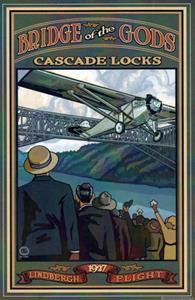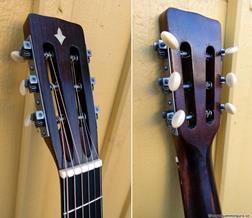Has a customer in the US, has received several unusual and fine guitars from him for GammelGura conversion. The latest in the line was a Supertone Artist from 1929, one of the finer models, with the unusual "Aero-bridge" or aircraft stable and extra bling in the form of abalone mother-of-pearl inlays. Bottom and side in Koa, lid in dense spruce ("red spruce"). The stable and main plate in rosewood, neck in mahogany and fretboard most likely in ebonised wood, possibly ebony.
You can read about the guitar model: “The Artist: Our Finest Guitar. We believe this is as fine a guitar in tone and construction as it is possible to buy. Genuine pearl inlaid guitar or Hawaiian koa wood construction. This guitar is of the special handcraft construction, and is fitted with the aero bridge (patent pending) to insure excellent tone quality. ”
You also call the stable (patent) for a “Lindbergh” stable. Charles Lindbergh was a sensation when he flew the first solo flight from the United States to France on May 21, 1927. Guitars and other instruments (ukulele, mandolin) were made with these stables during the years 1927-34 by Harmony. The interesting thing is that the stable began to be manufactured just before Lindbergh made his flight, even though the patent itself was filed in 1928 and approved in 1930. They were no stupider than riding the hype! The idea with the stable was otherwise to avoid the lid being deformed by the string, the stable was supplemented by a special rib on the inside where the "tail" of the stable rested on the cross in an X-rib. In Sears, Roebuck & Co., Spring and Summer Catalog, 1929, page 733 you can read:
“This invention relates to stringed musical instruments, such as guitars and the like, and its principal object is to improve the tone qualities of instruments of this type, and to remedy certain defects common to such instruments. In the ordinary guitar a narrow bridge is employed which is glued to the top of the instrument, but due to the strain thereon caused by the tension of the strings, the narrow bridge is often caused to tilt on one edge, thereby bending down the bowed top of the instrument between the bridge and the block at the neck, thereby impairing the tone quality of the instrument. Sometimes the strain is so great that the bridge is torn from the top, or is torn in two. One object of the invention is to provide a bridge for guitars, and the like, which overcomes all of said difficulties and greatly increases the effectiveness of the instrument.
The bridge is made relatively long and wide, thereby providing a gluing face on its underside of considerable area as compared to the gluing faces of bridges now on the market. The saddle receiving portion extends transversely of the instrument and the relatively long portion is preferably in the form of a projection narrower than the saddle receiving portion and extending at right angles thereto. The exact shape of the bridge is immaterial, broadly speaking, but by giving it an ornamental appearance, the attractiveness of the instrument is greatly enhanced.
On account of the great gluing surface of the bridge, it not only is secured more firmly to the top, but because of the long extent thereof, the tendency for the bridge to tilt, when subjected to the tension of the strings, is practically eliminated , and the tendency to flatten out the bowed part of the top between the bridge and block is eliminated. This also has a tendency to improve the tone volume of the instrument. The tension of the strings on the bridge is considerable, as is well known, but by increasing the length of the bridge, lengthwise of the instrument, a greater hold on the top is obtained with the result that the tendency of the bridge to tilt and bend down the bowed top is eliminated. More or less variation of the exact details of construction is possible without departing from the spirit of this invention; I desire, therefore, not to limit myself to the exact form of the construction shown and described ”
This guitar had a fairly typical ladder bracing, the two ribs below the sound hole were angled to a horizontal V. A spruce stable plate, cracked around the string pin holes, covered half the lid almost to the edge on one side. A little funny that the stable on this one had been torn off by the string pull, just one of the things the stable would prevent! 🙂 The thin lid, too strong strings and the lack of matching ribs on the inside was probably the reason why the stable came loose.
- Total length: 97 cm
- Top (upper round, waist, lower round): 25 - 21 - 35,5 cm
- Side (neck block, waist, end block): 8,5 - 9,7 - 9,7 cm
- Neck: V-shape
- Fingerboard (nut, 12th, bridge): 48 - 57 - 58 mm
- String length: 64 cm
- Varnish: Cellulose overcoated with alcohol
- Weight: 1343 g
There was no label or marking in the guitar which was in poor condition. The bottom third and the binding board were missing. The lid was cracked, shrunk and broken, the stable was almost loose and had pulled a piece of the lid under the stable. The stable was in good condition. The neck was loose. The bottom and side were whole even though the bottom had shrunk some. The tuning screws were a big gap.
Loosen what was left of the fretboard and a carbon fiber rod was glued in. The holes for the tuning screw posts were drilled to mount the "grommets", but did not need to be plugged as the distance between the posts on modern tuning screws are those that have been used as standard in the US since the turn of the century.
Bonding of the reinforcements around the sound holes in the fir plate in spruce. Kerfingen had not been replaced yet.
Unloading the bottom is always a problem with finer binding guitars. By this the skin glue had aged and it was almost possible to get loose bottom with the binding remaining without having to look through the notching. Changed to new notching and had intended to reuse the bottom plus binding as it was, but it turned out that the bottom shrunk and did not fit the sides without using too much force. Got to plan B. The old bond was sacrificed and replaced with a new one. With the rolls, I was able to make a white and a turtle-colored binding that matched the original in thickness. Started by gluing in a thin rosewood strip at the bottom also because the cut in some places was 3 mm and the binding 2 mm wide. A lot of work!
The beginning of the bottom glue with a new notch mounted, uses a heat lamp to gain time with the skin glue.
The new binding around the bottom is milled and glued in place, the new ebony board under work.
All cracks and loose pieces in the lid were jumbled together and glued. Since the lid is only about 2,5 mm thick, a number of layer patches and a larger spruce patch were needed to reinforce the lid with between ribs two and three below the sound hole. In some places, the lid also had to be glued to the sides. The bottom and sides were in good condition, only the middle seam on the bottom needed to be glued together. It got the usual ribbing with barn plate in spruce and plugs.
The other major job was to make a new ebony fingerboard. It had a slight 20 ″ radius and all mother-of-pearl inlays were moved over, the two squares at the 12th band were newly manufactured. The same binding used at the bottom was glued to the edges of the fretboard. For once, I chose regular nickel bands instead of brass, looks better on this guitar.
With a new grip board, it was easy to choose a mens watch that matched the position of the stool leg on the stables. The measurement for the oversaddle intonation was a little more complicated than normal due to the structure of the stable, but it went well. With 64 cm mens watch, the compensation for the oversaddle and stables was different than I am used to (with 62-63 cm mens watch). The G string intonation point came closest to the 1st band, otherwise it is always the A or B string. At the stable, the intonation points ended up almost straight, which meant that I could make the stable bone only about 3,5 mm thick to reach all intonation points. Has gotten better at grinding the relief and the straps on the grip board and finding the right height on the stable leg, this was very well adjusted.
The sizing of the neck.
The varnish was brittle and loose in its places, the colored varnish had stained loosely. Used potassium permanganate and a little stain to cushion the worst damage before applying a layer of spirits on top of the cellulose varnish. Spray varnish adheres well to cellulose varnish and can be sprayed off if desired.
I must say that it sounds very good with its plugs and segmented stable legs! I doubt that the stable is good for the sound quality, but since the lid is large and the stable does not bind together more than one bar inside, there may not be a major change for the better with a regular stable. The thin lid, high volume and the slightly wider fretboard make it suitable for finger play. Koa wood at the bottom and side also gives a fuller and more alkaline tone than I am used to from maple and birch. The larger air volume in the guitar gives a little more "inner reverb" from the box. I always want to keep the just finished guitar, but I think it turned out extra good, albeit a little too big 🙂




















